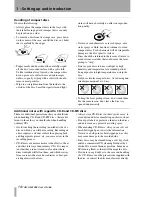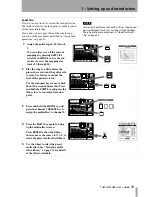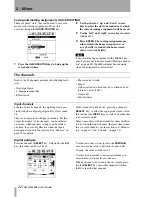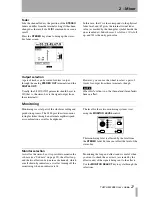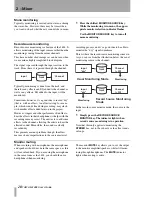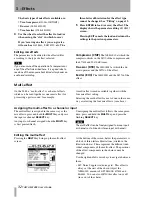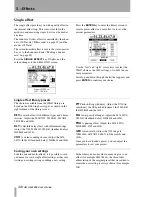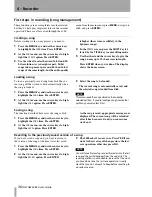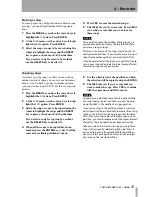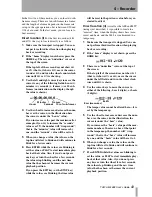
2 – Mixer
28
TASCAM 2488
User’s Guide
Mono monitoring
Typically monitoring is carried out in stereo, echoing
the stereo bus. However, there may be times when
you want to check what the mix sounds like in mono.
1
Press the shifted
MONITOR SOURCE
key.
While the monitoring is in mono, the appro-
priate monitor selection indicator flashes.
Use the
MONITOR SOURCE
key to turn off
mono monitoring.
Record source monitoring
Record source monitoring is a feature of the 2488. It
allows monitoring of the input sources rather than the
monitoring coming from the mixer channels.
This has a number of advantages as can be seen when
we examine a highly simplified block diagram.
The signal is passed through the input section, to the
track. From there, it is passed through the channel.
Typically, monitoring is done from the track, and
therefore any effects and EQ added to the channel, as
well as any effects, EQ added to the input, will be
monitored.
Sometimes, however, it’s a good idea to record “dry”
(that is, with no effect). An effect setting, for exam-
ple, which sounds fine during recording, may clash
with another effect added later on in the project.
However, singers and other performers often like to
hear the effects in their headphones (it helps with the
recording in many cases). The answer is to add some
effects to the channel, allowing the artiste to hear the
effected sound. Meanwhile, the sound is actually
recorded dry.
This presents a minor problem, though; the effect
may mask any imperfections in the source material
recording process, and it’s a good idea to be able to
monitor the “dry” signal sometimes.
This is where the record source monitoring comes in.
As you can see from the illustration below, the usual
monitoring source is the channel.
In the record source monitor mode, the source is the
input.
1
Simply press the
RECORD SOURCE
MONITOR
key. The indicator lights when
record source monitoring is in operation.
Note that this only applies to monitoring the
STEREO
bus, not to the sub mix or the effect sends
or loops.
Monitor muting
When recording with microphones, the microphones
and speakers should not be in the same space, as this
will cause feedback. If you are using the microphone
in the same room as the 2488, you should then use
headphones when monitoring.
The monitor
MUTE
key allows you to cut the output
to the monitor amplifier/speakers, while still moni-
toring through headphones. The
MUTE
indicator
lights when muting is active.
Input
Channel
Track
Input
"dry"
Channel
(+ FX)
Track
Input
"dry"
Channel
(+ FX)
Track
Monitoring
Record Source Monitoring
Mode
Usual Monitoring Mode
Monitoring

